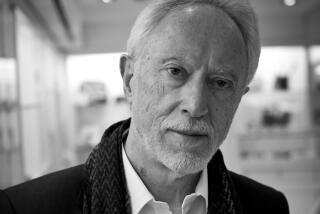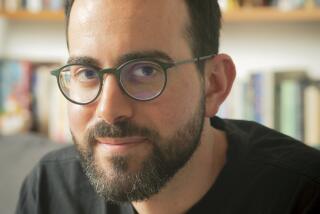Somebody Else’s Life by Morris Philipson (Harper & Row: $16.95; 298 pp.)
- Share via
Pity the poor professor of humanities when the life of the mind seems moribund by middle age.
Appreciate the desire to leave the seat of learning and start living by the seat of the pants.
Understand the plight of Stephen Cooper--a doctor of philosophy, a master of academic pretension and a bachelor of promiscuity--who suddenly realizes having missed the more important material pleasures. A family wedding was what did it. There was Cooper, on sabbatical from Northwestern, surrounded by the trappings of his brother’s Georgetown estate: swimming pool, billiard room, ceramics collection and Silver Cloud Rolls-Royce. Envy began to grow: “Not only was he tired of himself, he was disappointed by himself,” with nothing ahead but the wrinkles of age and the agonies of repetition.
Novelist Morris Philipson presents another profile of the scholar manque, the learned man who learned, perhaps too late, that he had some other life in mind. The writer knows such familiar characters, having been a professor of philosophy, an author of scholarly works and currently the director of the University of Chicago Press. He also knows his way around less ivy environments; in Philipson’s fifth novel, the protagonist professor becomes a bunco artist, turning his considerable knowledge of history into a spectacular scam based on gifts brought to Henry VIII by Catherine of Aragon.
And Cooper has the perfect partner in crime; his most recent mistress happens to be a conservator at the Art Institute of Chicago, an expert in preservation and provenance, with frustrations and unfulfilled ambitions of her own.
Alice Jensen Chase and Cooper begin the heroic effort of dual creation--making a bogus masterpiece that will convince collectors and assuming a singular new identity. Leslie Egmont, they decide, could be a man or woman. While Leslie the woman practiced the art of counterfeit, Leslie the man could open a Swiss bank account for deposit of real money. They even wed, a marriage of both connivance and convenience.
The details are mostly delicious. Stephen’s Leslie wears a silver wig and warts on his cheek. Alice’s Leslie finds a suitor at Museo del Prado in Madrid. They meet a world of curators who are not above making the kind of whispered deals that do-in Wall Street brokers. Stephen becomes so fond of Leslie that he writes letters to his other ego, rationalizing the modern failure of philosophy: “Not only young students but aging faculty members appear to be taken in by the idea that we do not use language in order to arrive at truth. . . . On the contrary, they believe that language thinks us; language is reified to a causative power, the way Marxist thinkers used the idea of history, for the past 100 years.” Such discursion becomes a side order of satire: You can get the professor into a new posture, but you can’t get the posturing out of the professor.
Many philosophers may be amused, but some logicians will be annoyed. Leslie Egmont passes himself and herself off, among curators, as a consultant to the Chicago Art Institute. Even corrupt curators would check such easily checkable credentials, but they do not.
Then, when the two Leslie Egmonts have made their kill, the creative thieves fall out and the plot thins. Perhaps Philipson wanted exactly such emotional distance, but the reader learned to care about Cooper without much caring for him; when he disappears, he is hardly missed. As in action painting, the art is more in the performance than on--or off--the wall. For most of the action, Leslie Egmont performs brilliantly.
More to Read
Sign up for our Book Club newsletter
Get the latest news, events and more from the Los Angeles Times Book Club, and help us get L.A. reading and talking.
You may occasionally receive promotional content from the Los Angeles Times.






